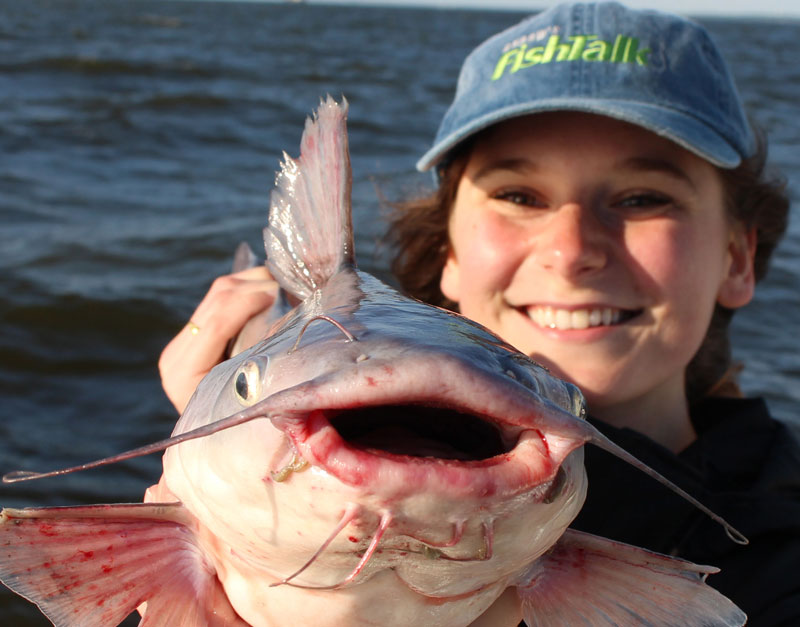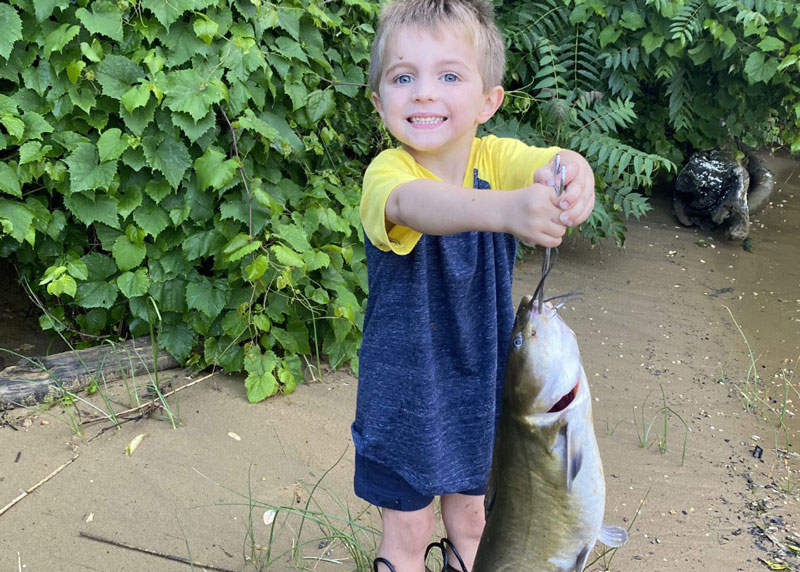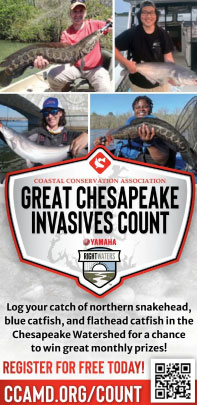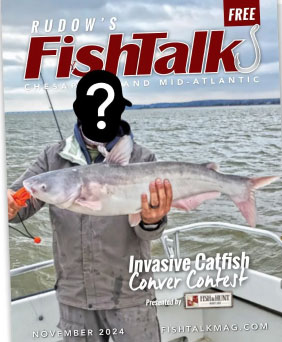
If you live anywhere near Chesapeake Bay and you like fast angling action that results in tasty fish on the plate, there’s a good chance you’ll find yourself fishing for blue catfish in the near future. And if you do, you can also toss your hat in the ring to be on the cover of FishTalk in the Invasive Catfish Cover Contest. No doubt you already know that blue cats can now be found in virtually all of our waterways, often in ridiculously large numbers. But nothing in fishing is a sure thing. Targeting blue catfish may be about as close as it comes, but you can boost your odds of success even more by putting these 10 catfish-catching tips to work.

- Check out the Maryland Catfish Trail. Even if you already have a favorite hotspot, there could be many more right around the corner which you haven’t visited yet. The Trail details dozens of them all across the state and has all the detailed info you need to set up your next blue cat fishing foray.
- If a strong front has moved through, which can sometimes depress the bite, look for deep holes and sink your baits in the deepest part. Often the pressure changes associated with fronts will cause the fish to go as deep as they possibly can and sit there.
- Forget all those weird baits that the catfish will eat, like hot dogs and chicken nuggets. Yes they will eat them, but they’ll eat a chunk of cut bunker or gizzard shad a whole lot more often.
- When possible, get fresh bait as opposed to frozen. They often won’t show a preference but on occasion they will, and in any case, fresh stays on the hook a lot better.
- Use very large circle hooks. A 10/0 or 12/0 hook might seem huge in comparison to what you’re used to, but catfish have rather massive mouths and those big hooks will cut down on unwanted bycatch of other smaller species.
- If you aren’t getting a lot of bites try a floater rig (with a float on the leader pushed up to the hook eye). Sometimes the catfish hover a foot or two off the bottom, and this can put the bait right in front of them.
- Try to place your baits along drop-offs and channel edges. Often the catfish will school up halfway down a drop.
- Catfish like structure, too, so if you can locate a tree or deadfall laying right on the edge of a channel or drop-off you’ve found a prime hotspot.
- Rig up with fairly heavy leader of 50-pound test or more. The leader is likely to get rubbed across structure, shells, and other chaffing items, and you don’t have to worry about these fish being leader shy.
- Don’t grab your rod and start reeling at the first jiggle of the tip. Catfish often play with a bait before inhaling it all the way down so wait for the fish to start swimming off before reeling the line tight.

The Blue Catfish Chesapeake Invasion
Why are these fish suddenly appearing in massive numbers throughout so many of our waterways? There are numerous reasons ranging from their unintentional importation to climatic changes. But the bottom line remains the same: today, here on the Chesapeake, invading invasive species are on the loose and scarfing down our native fingerling fish, blue crabs, and grass shrimp.
Snakeheads and flathead catfish can prove problematic in certain waterways, but the biggest and most widespread invasive offender is without question the blue catfish. We’ve been bringing you one article after the next on where to find them, how to catch them, and how to cook them. We’ve introduced you to the new Maryland Blue Catfish Trail, rife with information on easily accessible shoreline fishing hotspots that are great for full family fishing trips. We’ve begged you to remove them from the ecosystem rather than releasing them. And we’ve spent many of our own fishing days casting chunks of bunker on circle hooks and reeling back those fat blue cats.

Now we’re asking you to do one more thing — something you probably do already when you make an outstanding catch. Take a picture of that fish on a ruler, and “report” it to the “authorities.” This may sound a tad bit like vigilantism, but in truth it’s closer to citizen science. When you take a picture of that blue catfish, flathead catfish, or snakehead, and upload it to the Great Chesapeake Invasives Count via the iAngler app (which takes all of about 30 seconds) the data you’ve collected gets shared with the fisheries scientists tasked with handling this crisis. Better still is if you slice open the fish’s stomach and photograph the contents, then upload that into the system as well.
All of us should be willing to register for the Great Chesapeake Invasives Count (which is absolutely free) and upload these photos as a matter of being responsible anglers working to protect our environment. But on top of that, it’s entirely self-serving — if the scientists can figure out how to secure our Bay’s borders our native fisheries stand to reap the benefit, which means there will be more rockfish, perch, and blue crabs for us all to go out and catch.
Each and every time you upload a picture of one of those invasives and/or you upload a picture of the stomach contents, your name goes into the Great Chesapeake Invasives Count prize drawing. It works sort of like raffle tickets; the more entries you amass the better your chances of winning. And this isn’t for a mere single prize. Through the course of the count there will be monthly drawings for all sorts of sweet goodies. Sure, there’s the usual stuff like T-shirts and tumblers, but there are also some prizes worth serious cha-ching like high-end Marucci sunglasses, coolers, and gift certificates to fishing tackle shops. And remember people, you can win all this stuff without ever laying out a dime—all you have to do is register, take those pictures, and upload them onto the iAngler tournament app. Winners will be announced monthly, on Live with Lenny.
Interdicting the Invaders
The Maryland DNR notes that due to factors such as a loss of biodiversity, altered food webs, and declines in native fisheries and habitat, invasive species like the blue catfish and the flathead catfish can cause significant ecological and/or economic harm. The department therefore asks anglers to:
- Remove and kill any invasive species they catch.
- Not release these fish when caught.
- Not transport these fish alive, which is not only discouraged but it also illegal (transport or unauthorized introduction of invasive species should be reported to the Natural Resources Police, at 800-628-9944).
Cover Contest: Be FishTalk's Next Cover Model!

You say you’d love to see yourself or your kid grace the cover of FishTalk Magazine? We can make that happen! When you hit the Catfish Trail be sure to take plenty of pictures. They need to be:
- In a vertical upright format, with room at the top and bottom for the title and cover blurbs.
- High resolution and in focus.
- Showing a blue or flathead catfish caught in Maryland waters and an angler or anglers with BIG SMILES on their faces!
We are now accepting entries, so be sure to snap off some awesome cover-style photos as you enjoy angling for those catfish all summer long — you never know, you might just end up on the cover of FishTalk!
See Bue Catfish in the Bullseye, Part I, for catfish fishing basics and an introduction to the Catfish Trail, and Blue Catfish in the Bullseye Part III for some tips and tricks to catch a new PB.